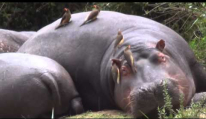Communication
The call of the yellow-billed oxpecker is a crackling kriss, kriss.
Behavior
Yellow-bills nest in tree holes that they line with hair plucked from their hosts. Yellow-bills that are not breeding will spend the night roosting on the mammal that provided their meal.
Conservation
The International Union for Conservation of Nature (IUCN) lists the status of the yellow-billed oxpecker as “lower risk.” However, its populations are declining primarily due to a reduction in the number of large game animals and the increased use of anti-tick cattle dips containing arsenic.
Diet
The yellow-billed oxpecker eats ticks, larvae, and blood.
Breeding
Yellow-billed oxpeckers nest in tree holes lined with hair plucked from their hosts. Females usually lay two or three eggs.
Friends & Foes
The yellow-billed oxpecker’s range overlaps that of the red-billed oxpecker. When both species feed on the same group of host animals, the yellow-bill is usually dominant.
Population in Kenya
Yellow-billed oxpeckers are found in western Kenya and throughout the savanna of sub-Saharan Africa.
Range & Habitat
Yellow-billed oxpeckers live in small flocks and can be found at sea-level or in mountains as high as 9,800 feet (3,000 m).








